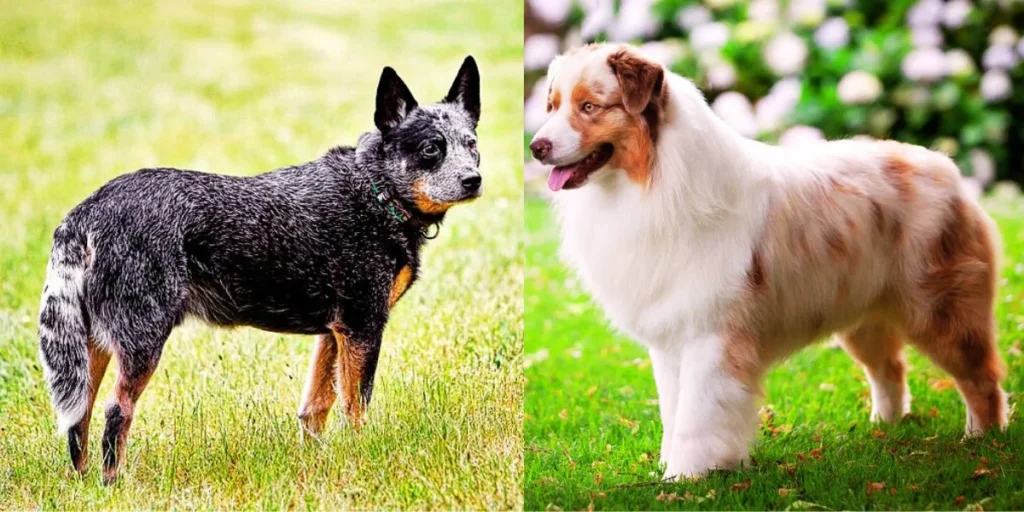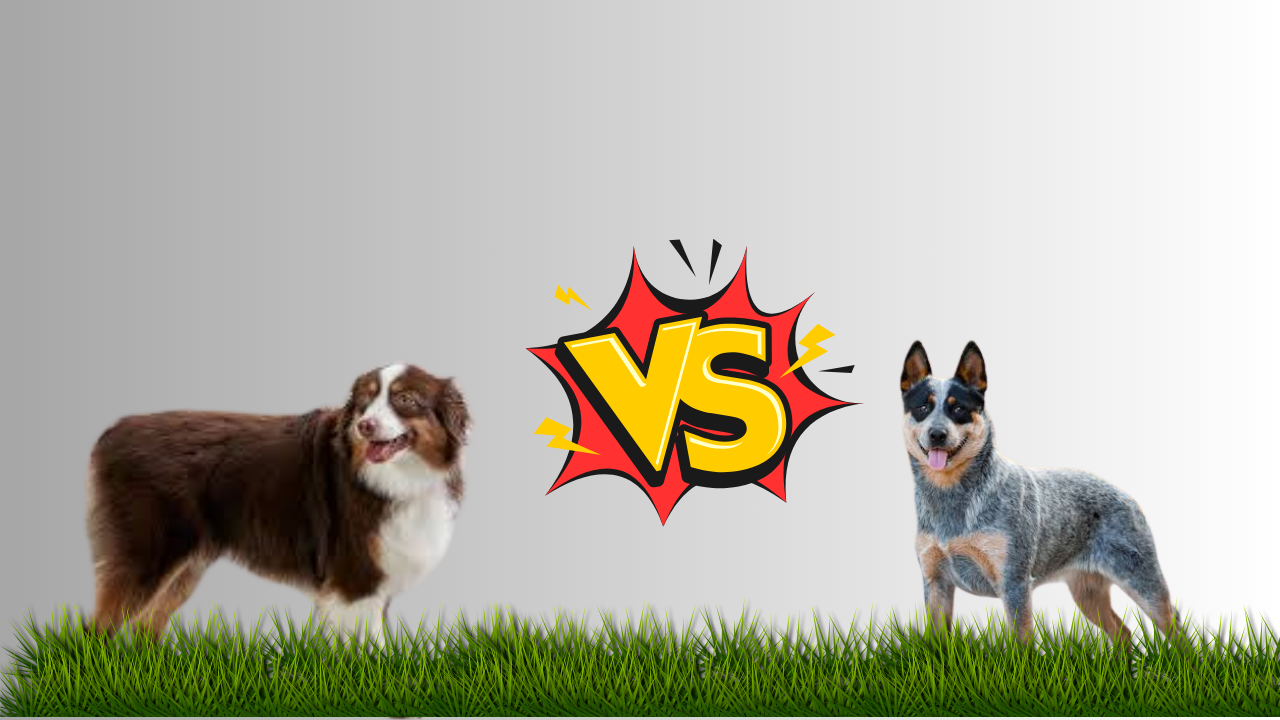When it comes to Australian Shepherd vs Cattle Dog understanding their differences can help you choose the right breed. The Australian Shepherd weighs 40-65 pounds, while the Cattle Dog is slightly smaller, at 35-50 pounds. Both are highly intelligent, but their energy levels and personalities vary.
The Australian Shepherd stands 18-23 inches tall and has a wavy coat, while the Cattle Dog is a bit more compact at 17-20 inches. The Shepherd is more eager to please, making training easier. On the other hand, the Cattle Dog is more independent but still thrives in active environments.
Which breed is better for first-time dog owners?

For first-time dog owners, the Australian Shepherd might be a better choice. While both breeds are intelligent and energetic, Australian Shepherds tend to be more adaptable and eager to please, which makes training easier. Explore the fascinating contrasts in African Wild Dog vs Raccoon Dog and Australian Shepherd vs Cattle Dog.
They are also more social and generally get along well with families, children, and other pets, making them a better fit for new dog owners. On the other hand, the Australian Cattle Dog, while equally smart, can be more independent, stubborn, and protective, requiring a more experienced owner who can handle their strong herding instincts and firm training needs.
Australian Shepherd vs Cattle Dog Differ

Origin and History
Let’s dive into the history of these two amazing breeds. Exploring the differences between Australian Shepherd vs Cattle Dog, we can better understand where they came from, which in turn helps to explain their unique traits and characteristics.
Australian Shepherd: A U.S. Creation
Though called the “Australian” Shepherd, this breed was actually developed in the United States. It was created in the 19th century to work on ranches, especially herding sheep. This breed’s name might be misleading, but their intelligence and work ethic are distinctly American.
Australian Cattle Dog: An Australian Legacy
The Australian Cattle Dog, on the other hand, comes from Australia. It was bred in the 1800s by mixing British herding dogs with native Dingoes. These dogs were specifically designed for herding cattle across Australia’s rough terrains, and they quickly became known for their toughness and stamina.
Physical Characteristics
When it comes to physical traits, the Australian Shepherd vs Cattle Dog comparison often highlights both their similarities and differences. While they share some common features, they also exhibit distinct characteristics. Let’s take a closer look at how they stack up against each other.
Size
The Australian Shepherd tends to be a bit larger than the Australian Cattle Dog. Aussies typically stand between 18 and 23 inches tall, and they weigh between 40 and 65 pounds. In contrast, the Cattle Dog is a bit more compact, standing at 17 to 20 inches tall and weighing 35 to 50 pounds.
Coat and Colour
When it comes to coats, the Australian Shepherd has a medium-length, wavy, or curly coat, which is a bit more prominent. Their coat comes in various colors such as black, blue merle, red, and red merle. On the other hand, the Cattle Dog has a shorter, dense coat, with colors that range from blue and red to blue mottled.
Distinct Features
If you’ve ever seen these two breeds, you’ll notice their distinct physical features. The Australian Shepherd has a bushy tail and floppy ears, giving them a friendly look. The Cattle Dog, however, has erect ears and a more fox-like tail, which gives them a sharper, more alert expression.
Temperament and Personality
In this section, we’ll take a closer look at the temperaments and personalities of the Australian Shepherd and Australian Cattle Dog. When comparing Australian Shepherd vs Cattle Dog, it’s clear that both breeds have unique traits that make them stand out, so it’s important to understand what each breed is like.
Australian Shepherd Personality
Australian Shepherds are known for their friendly and affectionate nature. They typically form strong bonds with their family, often becoming attached to one person in particular. With a friendly disposition, they are generally good with children, other dogs, and even other pets in the household.
Australian Cattle Dog Personality
In contrast, Australian Cattle Dogs are more independent and protective. While they are incredibly loyal, they can be reserved, especially around strangers. They are known for their “one-person” attitude, often bonding closely with their owner and being a bit more cautious around others.
Energy Levels: Australian Shepherd vs. Australian Cattle Dog
When it comes to energy levels, both dogs are highly active, but they differ in intensity. The Australian Shepherd needs about 1 to 2 hours of exercise daily, while the Australian Cattle Dog requires a bit more, usually around 1.5 to 2 hours, especially if they have a job to do. These breeds thrive on physical and mental stimulation, so a sedentary lifestyle isn’t ideal for either.
Herding Instincts and Social Behaviors
Both breeds have strong herding instincts, but the Australian Shepherd tends to be a little more adaptable in a social setting. They’re comfortable around large groups and are known for their ability to work well in teams. The Australian Cattle Dog, on the other hand, can be more focused and protective, often working better in one-on-one scenarios or small groups.
Interaction with Children and Other Pets
When it comes to families, the Australian Shepherd is usually better with younger children and other pets, thanks to their friendly and social nature. They are patient and playful with kids, making them a great family dog. The Australian Cattle Dog may need more careful supervision, especially with smaller children, as their herding instinct can sometimes cause them to nip or herd kids, unintentionally.
Exercise and Training Needs
Both the Australian Shepherd and Australian Cattle Dog are high-energy breeds that require significant exercise and mental stimulation. Let’s dive into their specific needs to see how they compare when it comes to staying active and sharp.
Australian Shepherd Exercise Needs
The Australian Shepherd is a very active dog, needing about 1-2 hours of exercise daily. Whether it’s playing fetch, running alongside you, or practicing agility, this breed thrives when it’s moving. Without enough exercise, they can quickly become bored and potentially destructive.
Australian Cattle Dog Exercise Needs
The Australian Cattle Dog is even more intense, needing a minimum of 1.5-2 hours of vigorous exercise every day. They’re built for working, so activities that engage their herding instincts are perfect. If you don’t keep them busy, they’ll find a way to entertain themselves—often in ways you won’t like!
Training Needs: Australian Shepherd
Australian Shepherds are extremely intelligent and love having a job to do. They’re easy to train, and they respond well to positive reinforcement methods, making them great for tasks like obedience and agility. With their eagerness to please, they’ll be at their best when trained with patience and praise.
Training Needs: Australian Cattle Dog
While intelligent, the Australian Cattle Dog has an independent streak and needs a firm, consistent trainer. They can be a bit stubborn, so training requires strong leadership. A lack of structure might lead them to take matters into their own paws, so to speak!
Mental Stimulation for Both Breeds
Both breeds excel in environments that challenge their minds. Australian Shepherds love puzzle toys, and Australian Cattle Dogs thrive on tasks like herding or playing with interactive toys. Their intelligence is their greatest asset, but also their biggest challenge for owners who need to keep them entertained
Health and Lifespan
When it comes to choosing a dog, health and lifespan are often top of mind. Both the Australian Shepherd and the Australian Cattle Dog are strong breeds, but they do come with their own set of health challenges. In this section, I’ll break down the common health issues and how long each breed typically lives.
Common Health Issues
The Australian Shepherd, being an active and energetic dog, can be prone to several health conditions. They are especially susceptible to hip and elbow dysplasia, which occurs in about 15-20% of the breed. Additionally, eye issues like cataracts and progressive retinal atrophy (PRA) are fairly common, affecting roughly 10-15% of Aussies.
On the other hand, the Australian Cattle Dog shares similar issues, such as hip dysplasia. But they’re also more likely to experience progressive retinal atrophy (PRA), with studies showing that around 10% of them might develop this condition. Deafness is another common issue, particularly in blue-colored Cattle Dogs, affecting about 5-8% of the breed.
Lifespan
When it comes to lifespan, both breeds live relatively long lives for their size. Australian Shepherds typically live between 12 and 15 years, with many enjoying good health throughout their lives when properly cared for. Regular exercise and a balanced diet can often help extend their lifespan by a few years.
The Australian Cattle Dog has a slightly longer lifespan, averaging between 12 and 16 years. Cattle Dogs tend to have a higher energy level, and as a result, they can often live a bit longer. With proper care, many Cattle Dogs can live well into their mid-teens, maintaining their health until the end.
Health Considerations
Both breeds are generally healthy, but their unique physical traits can lead to specific health concerns. For Australian Shepherds, their merle coat color can sometimes cause issues with their vision and hearing. It’s estimated that about 5-10% of merle-coated Aussies may experience congenital deafness or eye defects.
For Cattle Dogs, their high activity levels can lead to joint problems, especially as they age. Regular checkups and monitoring their physical health can help detect conditions early on. Some Cattle Dogs also experience dental problems, so keeping an eye on their teeth is important for maintaining overall health.
Suitability as Family Pets
When it comes to choosing a dog for your family, it’s important to consider how they’ll fit into your lifestyle. Both the Australian Shepherd and Australian Cattle Dog are fantastic working dogs, but they differ when it comes to their suitability as pets in a family setting. Here’s a breakdown of what you can expect from each breed.
Australian Shepherd: Great for Active Families
The Australian Shepherd is known for being a friendly and adaptable breed, making it a great choice for active families. They thrive in households where there is lots of outdoor activity, such as running, hiking, or playing fetch. With an average height of 18-23 inches and weight of 40-65 pounds, they are big enough to be sturdy but not overwhelming for most homes.
Australian Cattle Dog: Best for Experienced Owners
On the other hand, the Australian Cattle Dog, with its high drive and intense focus, is better suited for experienced owners. They are highly protective and can be a bit reserved around strangers, making them ideal for families with older children or those who are familiar with dog training. These dogs are usually 17-20 inches tall and weigh between 35-50 pounds.
Training Considerations for Families
Both breeds require consistent training, but the Australian Shepherd is typically more eager to please and easier to train. In contrast, the Australian Cattle Dog has a stronger independent streak and may require firmer, more structured guidance. If you have a family with young children, the Shepherd’s friendly nature may make it a better fit, while the Cattle Dog might need a more structured environment.
Socialization Needs
Socializing both dogs early is key, but the Australian Shepherd is generally more social and can be more easily integrated into a family environment. They tend to get along with other pets and animals if introduced properly. The Australian Cattle Dog, however, has a more intense territorial instinct and may need extra socialization to get along with other animals and strangers.
Exercise and Play
Both breeds require significant exercise, but the Australian Shepherd needs a bit more time to unwind after a day of activity. With their high intelligence and energy, they are happy after a solid workout or task. Meanwhile, the Australian Cattle Dog, with its unrelenting drive, will still need more mental stimulation even after a run, and they are happiest when they have a job to do, whether it’s herding or guarding.
Grooming Considerations for Families
Grooming is also a factor in how easy these breeds are to maintain in a family setting. The Australian Shepherd, with its medium-length, wavy coat, needs regular brushing, especially during shedding seasons. In contrast, the Australian Cattle Dog’s shorter coat requires less maintenance, but it still sheds, so you’ll need to brush it regularly to keep their fur healthy and minimise shedding.
Understand the primary differences between Husky and Wolf Dog.
Intelligence and Trainability
In this section, we’ll dive into how both the Australian Shepherd and Australian Cattle Dog stack up when it comes to intelligence and trainability. Whether you’re looking for a dog to impress you with its tricks or need a reliable working dog, both breeds have something to offer.
Australian Shepherd’s Intelligence
The Australian Shepherd is often ranked as one of the most intelligent dog breeds, coming in at #1 in many lists of smart dogs. This breed is quick to pick up commands, with some studies showing they can learn a new task in just 5 repetitions. They thrive when engaged mentally and love to work, which makes them excellent candidates for advanced training or dog sports.
Trainability of Australian Shepherd
Thanks to their intelligence, Australian Shepherds are highly trainable. On the Canine Intelligence scale, they rank #1, meaning they can obey first commands 95% of the time or more. They are eager to please, which makes them quick learners, but they can also become stubborn if bored or under-challenged, so keep them engaged.
Australian Cattle Dog’s Intelligence
The Australian Cattle Dog is equally intelligent but has a different approach. Ranked #10 for intelligence, they are incredibly sharp and can figure out complex tasks, particularly when they involve work or purpose. These dogs can master new commands in less than 5 repetitions, although they may prefer to take the lead in certain situations, making them appear more independent.
Trainability of Australian Cattle Dog
When it comes to training, the Australian Cattle Dog is a little more challenging. While they are extremely smart, they often show a strong independent streak. They are ranked #10 in terms of trainability, meaning it can take more time to earn their trust. With the right, firm approach, they can be trained effectively, but their strong-willed nature requires consistent discipline.
Which Dog Is Easier to Train?
While both dogs are highly intelligent, the Australian Shepherd’s eagerness to please gives it an edge when it comes to easy training. They are naturally more obedient and can be a little easier for first-time dog owners to train. On the other hand, the Australian Cattle Dog’s independence can make them more challenging to train, especially for beginners, though with dedication, they are still highly capable learners.
Grooming Needs
When it comes to grooming your dog, knowing the requirements of each breed is essential. Both the Australian Shepherd and the Australian Cattle Dog have distinct grooming needs that are tied to their coats and activity levels.
Australian Shepherd Grooming Needs
The Australian Shepherd has a medium-length, wavy coat that requires regular care. Ideally, you should brush your Aussie at least 2-3 times a week to prevent mats, especially during shedding seasons. They shed moderately year-round but expect heavy shedding in spring and fall, so be ready for extra brushing.
Australian Cattle Dog Grooming Needs
In contrast, the Australian Cattle Dog has a short, dense coat that’s much easier to maintain. A simple weekly brushing is enough to keep their coat clean and healthy. They do shed, but their shedding is less intense compared to the Australian Shepherd, so it’s a little less time-consuming overall.
Special Grooming Considerations
Both breeds benefit from occasional baths to keep their coats looking fresh, but don’t overdo it bathe them about every 1-2 months to avoid drying out their skin. They may also need their nails trimmed every 3-4 weeks to ensure they don’t become too long and cause discomfort.
Final Words
When it comes to choosing between the Australian Shepherd vs Cattle Dog, both breeds have unique qualities. The Australian Shepherd, standing at 18-23 inches tall and weighing 40-65 pounds, is known for its friendly, energetic nature.
On the other hand, the Cattle Dog, slightly smaller at 17-20 inches and 35-50 pounds, is more independent and protective. Each breed is great for active families, but knowing their exercise and training needs will help you make the best choice for your lifestyle.
Discover the unique traits of these sleek breeds in Italian Greyhound vs Whippet Dog.



